Linearized Single-Scattering Property Database for Hexagonal Prism Ice Particles
Abstract
1. Introduction
2. Materials and Methods
2.1. Parameters
2.2. Model and Algorithms
3. Results
3.1. Integrated Scattering Properties
3.2. Differential Scattering Properties
4. Discussion
5. Conclusions
Author Contributions
Funding
Data Availability Statement
Conflicts of Interest
References
- Boucher, O.; Randall, D.; Artaxo, P.; Bretherton, C.; Feingold, G.; Forster, P.; Kerminen, V.-M.; Kondo, Y.; Liao, H.; Lohmann, U. Clouds and aerosols. In Climate Change 2013: The Physical Science Basis. Contribution of Working Group I to the Fifth Assessment Report of the Intergovernmental Panel on Climate Change; Cambridge University Press: Cambridge, UK, 2013; pp. 571–657. [Google Scholar]
- Liou, K.N. An Introduction to Atmospheric Radiation; Elsevier Science: Amsterdam, The Netherlands, 2002. [Google Scholar]
- van de Hulst, H.C. Light Scattering by Small Particles; Courier Corporation: Chelmsford, MA, USA, 1981. [Google Scholar]
- Mishchenko, M.I.; Hovenier, J.W.; Travis, L.D. Light Scattering by Nonspherical Particles: Theory, Measurements, and Applications; Elsevier: Amsterdam, The Netherlands, 1999. [Google Scholar]
- Mishchenko, M.I.; Travis, L.D.; Lacis, A.A. Scattering, Absorption, and Emission of Light by Small Particles; Cambridge University Press: Cambridge, UK, 2002. [Google Scholar]
- Bohren, C.F.; Huffman, D.R. Absorption and Scattering of Light by Small Particles; John Wiley & Sons: Hoboken, NJ, USA, 2008. [Google Scholar]
- Born, M.; Wolf, E. Principles of Optics: Electromagnetic Theory of Propagation, Interference and Diffraction of Light; Elsevier: Amsterdam, The Netherlands, 2013. [Google Scholar]
- Liou, K.N.; Takano, Y. Light scattering by nonspherical particles: Remote sensing and climatic implications. Atmos. Res. 1994, 31, 271–298. [Google Scholar] [CrossRef]
- Mie, G. Beiträge zur Optik trüber Medien, speziell kolloidaler Metallösungen. Ann. Der Phys. 1908, 330, 377–445. [Google Scholar] [CrossRef]
- Lorenz, L.V. Upon the light reflected and refracted by a transparent sphere. Vidensk. Selsk. Shrifter 1890, 6, 1–62. [Google Scholar]
- Kahnert, F.M. Numerical methods in electromagnetic scattering theory. J. Quant. Spectrosc. Radiat. Transf. 2003, 79, 775–824. [Google Scholar] [CrossRef]
- Sun, B.; Bi, L.; Yang, P.; Kahnert, M.; Kattawar, G. Invariant Imbedding T-Matrix Method for Light Scattering by Nonspherical and Inhomogeneous Particles; Elsevier: Amsterdam, The Netherlands, 2019. [Google Scholar]
- Johnson, B.R. Invariant imbedding T-matrix approach to electromagnetic scattering. Appl. Opt. 1988, 27, 4861–4873. [Google Scholar] [CrossRef] [PubMed]
- Waterman, P.C. Symmetry, unitarity, and geometry in electromagnetic scattering. Phys. Rev. D 1971, 3, 825. [Google Scholar] [CrossRef]
- Mishchenko, M.I.; Travis, L.D.; Mackowski, D.W. T-matrix computations of light scattering by nonspherical particles: A review. J. Quant. Spectrosc. Radiat. Transf. 1996, 55, 535–575. [Google Scholar] [CrossRef]
- Mishchenko, M.I.; Zakharova, N.T.; Videen, G.; Khlebtsov, N.G.; Wriedt, T. Comprehensive T-matrix reference database: A 2007–2009 update. J. Quant. Spectrosc. Radiat. Transf. 2010, 111, 650–658. [Google Scholar] [CrossRef]
- Mishchenko, M.I. Comprehensive thematic T-matrix reference database: A 2017–2019 update. J. Quant. Spectrosc. Radiat. Transf. 2020, 242, 106692. [Google Scholar] [CrossRef]
- Mishchenko, M.I.; Travis, L.D.; Mackowski, D.W. T-matrix method and its applications to electromagnetic scattering by particles: A current perspective. J. Quant. Spectrosc. Radiat. Transf. 2010, 111, 1700–1703. [Google Scholar] [CrossRef]
- Bi, L.; Yang, P. Accurate simulation of the optical properties of atmospheric ice crystals with the invariant imbedding T-matrix method. J. Quant. Spectrosc. Radiat. Transf. 2014, 138, 17–35. [Google Scholar] [CrossRef]
- Sun, B.; Yang, P.; Kattawar, G.W.; Zhang, X. Physical-geometric optics method for large size faceted particles. Opt. Express 2017, 25, 24044–24060. [Google Scholar] [CrossRef] [PubMed]
- Chen, X.; Wang, J.; Gomes, J.; Dubovik, O.; Yang, P.; Saito, M. Analytical Prediction of Scattering Properties of Spheroidal Dust Particles With Machine Learning. Geophys. Res. Lett. 2022, 49, e2021GL097548. [Google Scholar] [CrossRef]
- Yu, J.; Bi, L.; Han, W.; Wang, D.; Zhang, X. Jacobians of single-scattering optical properties of super-spheroids computed using neural networks. Opt. Express 2022, 30, 38513–38533. [Google Scholar] [CrossRef] [PubMed]
- Fu, Q.; Yang, P.; Sun, W.B. An accurate parameterization of the infrared radiative properties of cirrus clouds for climate models. J. Clim. 1998, 11, 2223–2237. [Google Scholar] [CrossRef]
- Hess, M.; Koepke, P.; Schult, I. Optical Properties of Aerosols and Clouds: The Software Package OPAC. Bull. Am. Meteorol. Soc. 1998, 79, 831–844. [Google Scholar] [CrossRef]
- Yang, P.; Wei, H.; Huang, H.-L.; Baum, B.A.; Hu, Y.X.; Kattawar, G.W.; Mishchenko, M.I.; Fu, Q. Scattering and absorption property database for nonspherical ice particles in the near- through far-infrared spectral region. Appl. Opt. 2005, 44, 5512. [Google Scholar] [CrossRef]
- Meng, Z.; Yang, P.; Kattawar, G.W.; Bi, L.; Liou, K.N.; Laszlo, I. Single-scattering properties of tri-axial ellipsoidal mineral dust aerosols: A database for application to radiative transfer calculations. J. Aerosol Sci. 2010, 41, 501–512. [Google Scholar] [CrossRef]
- Bi, L.; Yang, P.; Kattawar, G.W.; Kahn, R. Modeling optical properties of mineral aerosol particles by using nonsymmetric hexahedra. Appl. Opt. 2010, 49, 334–342. [Google Scholar] [CrossRef]
- Yang, P.; Bi, L.; Baum, B.A.; Liou, K.-N.; Kattawar, G.W.; Mishchenko, M.I.; Cole, B. Spectrally Consistent Scattering, Absorption, and Polarization Properties of Atmospheric Ice Crystals at Wavelengths from 0.2 to 100 μm. J. Atmos. Sci. 2013, 70, 330–347. [Google Scholar] [CrossRef]
- Dubovik, O.; Sinyuk, A.; Lapyonok, T.; Holben, B.N.; Mishchenko, M.; Yang, P.; Eck, T.F.; Volten, H.; Muñoz, O.; Veihelmann, B.; et al. Application of spheroid models to account for aerosol particle nonsphericity in remote sensing of desert dust. J. Geophys. Res. 2006, 111, D11. [Google Scholar] [CrossRef]
- Saito, M.; Yang, P.; Ding, J.; Liu, X. A comprehensive database of the optical properties of irregular aerosol particles for radiative transfer simulations. J. Atmos. Sci. 2021, 78, 2089–2111. [Google Scholar] [CrossRef]
- Bi, L.; Yang, P.; Kattawar, G.W.; Hu, Y.; Baum, B.A. Scattering and absorption of light by ice particles: Solution by a new physical-geometric optics hybrid method. J. Quant. Spectrosc. Radiat. Transf. 2011, 112, 1492–1508. [Google Scholar] [CrossRef]
- Bi, L.; Yang, P. Improved ice particle optical property simulations in the ultraviolet to far-infrared regime. J. Quant. Spectrosc. Radiat. Transf. 2017, 189, 228–237. [Google Scholar] [CrossRef]
- Baum, B.A.; Heymsfield, A.J.; Yang, P.; Bedka, S.T. Bulk Scattering Properties for the Remote Sensing of Ice Clouds. Part I: Microphysical Data and Models. J. Appl. Meteorol. Climatol. 2005, 44, 1885–1895. [Google Scholar] [CrossRef]
- Huang, H.-L.; Yang, P.; Wei, H.; Baum, B.A.; Hu, Y.; Antonelli, P.; Ackerman, S.A. Inference of ice cloud properties from high spectral resolution infrared observations. IEEE Trans. Geosci. Remote Sens. 2004, 42, 842–853. [Google Scholar] [CrossRef]
- Yang, P.; Gao, B.-C.; Baum, B.A.; Hu, Y.X.; Wiscombe, W.J.; Tsay, S.-C.; Winker, D.M.; Nasiri, S.L. Radiative properties of cirrus clouds in the infrared (8–13 μm) spectral region. J. Quant. Spectrosc. Radiat. Transf. 2001, 70, 473–504. [Google Scholar] [CrossRef]
- Baum, B.A.; Yang, P.; Heymsfield, A.J.; Bansemer, A.; Cole, B.H.; Merrelli, A.; Schmitt, C.; Wang, C. Ice cloud single-scattering property models with the full phase matrix at wavelengths from 0.2 to 100 µm. J. Quant. Spectrosc. Radiat. Transf. 2014, 146, 123–139. [Google Scholar] [CrossRef]
- Baum, B.A.; Yang, P.; Heymsfield, A.J.; Schmitt, C.G.; Xie, Y.; Bansemer, A.; Hu, Y.X.; Zhang, Z. Improvements in shortwave bulk scattering and absorption models for the remote sensing of ice clouds. J. Appl. Meteorol. Climatol. 2011, 50, 1037–1056. [Google Scholar] [CrossRef]
- Fu, Q.; Sun, W.; Yang, P. Modeling of scattering and absorption by nonspherical cirrus ice particles at thermal infrared wavelengths. J. Atmos. Sci. 1999, 56, 2937–2947. [Google Scholar] [CrossRef]
- Letu, H.; Ishimoto, H.; Riedi, J.; Nakajima, T.Y.; C-Labonnote, L.; Baran, A.J.; Nagao, T.M.; Sekiguchi, M. Investigation of ice particle habits to be used for ice cloud remote sensing for the GCOM-C satellite mission. Atmos. Chem. Phys. 2016, 16, 12287–12303. [Google Scholar] [CrossRef]
- Volten, H.; Muñoz, O.; Hovenier, J.W.; de Haan, J.F.; Vassen, W.; van der Zande, W.J.; Waters, L.B.F.M. WWW scattering matrix database for small mineral particles at 441.6 and. J. Quant. Spectrosc. Radiat. Transf. 2005, 90, 191–206. [Google Scholar] [CrossRef]
- Volten, H.; Muñoz, O.; Hovenier, J.W.; Waters, L.B.F.M. An update of the Amsterdam Light Scattering Database. J. Quant. Spectrosc. Radiat. Transf. 2006, 100, 437–443. [Google Scholar] [CrossRef]
- Muñoz, O.; Moreno, F.; Guirado, D.; Dabrowska, D.D.; Volten, H.; Hovenier, J.W. The Amsterdam–Granada Light Scattering Database. J. Quant. Spectrosc. Radiat. Transf. 2012, 113, 565–574. [Google Scholar] [CrossRef]
- Stephens, G.L.; Vane, D.G.; Boain, R.J.; Mace, G.G.; Sassen, K.; Wang, Z.; Illingworth, A.J.; O’connor, E.J.; Rossow, W.B.; Durden, S.L.; et al. The CloudSat mission and the A-Train: A new dimension of space-based observations of clouds and precipitation. Bull. Am. Meteorol. Soc. 2002, 83, 1771–1790. [Google Scholar] [CrossRef]
- Letu, H.; Nagao, T.M.; Nakajima, T.Y.; Riedi, J.; Ishimoto, H.; Baran, A.J.; Shang, H.; Sekiguchi, M.; Kikuchi, M. Ice Cloud Properties From Himawari-8/AHI Next-Generation Geostationary Satellite: Capability of the AHI to Monitor the DC Cloud Generation Process. IEEE Trans. Geosci. Remote Sens. 2019, 57, 3229–3239. [Google Scholar] [CrossRef]
- Rodgers, C.D. Inverse Methods for Atmospheric Sounding: Theory and Practice; World Scientific: Singapore, 2000; Volume 2. [Google Scholar]
- Maahn, M.; Turner, D.D.; Löhnert, U.; Posselt, D.J.; Ebell, K.; Mace, G.G.; Comstock, J.M. Optimal Estimation Retrievals and Their Uncertainties: What Every Atmospheric Scientist Should Know. Bull. Am. Meteorol. Soc. 2020, 101, E1512–E1523. [Google Scholar] [CrossRef]
- Wang, J.; Xu, X.; Ding, S.; Zeng, J.; Spurr, R.; Liu, X.; Chance, K.; Mishchenko, M. A numerical testbed for remote sensing of aerosols, and its demonstration for evaluating retrieval synergy from a geostationary satellite constellation of GEO-CAPE and GOES-R. J. Quant. Spectrosc. Radiat. Transf. 2014, 146, 510–528. [Google Scholar] [CrossRef]
- Wang, C.; Platnick, S.; Zhang, Z.; Meyer, K.; Yang, P. Retrieval of ice cloud properties using an optimal estimation algorithm and MODIS infrared observations. Part 2. Retrieval evaluation content. J. Geophys. Res. Atmos. 2016, 121, 5809–5826. [Google Scholar] [CrossRef]
- Wang, C.; Platnick, S.; Zhang, Z.; Meyer, K.; Yang, P. Retrieval of ice cloud properties using an optimal estimation algorithm and MODIS infrared observations. Part I: Forward model, error analysis, and information content. J. Geophys. Res. Atmos. 2016, 121, 5809–5826. [Google Scholar] [CrossRef]
- Hasekamp, O.P.; Landgraf, J. Linearization of vector radiative transfer with respect to aerosol properties and its use in satellite remote sensing. J. Geophys. Res. Atmos. 2005, 110, D04203. [Google Scholar] [CrossRef]
- Sun, B.; Gao, C.; Bi, L.; Spurr, R. Analytical Jacobians of single scattering optical properties using the invariant imbedding T-matrix method. Opt Express 2021, 29, 9635–9669. [Google Scholar] [CrossRef]
- Spurr, R.; Wang, J.; Zeng, J.; Mishchenko, M.I. Linearized T-matrix and Mie scattering computations. J. Quant. Spectrosc. Radiat. Transf. 2012, 113, 425–439. [Google Scholar] [CrossRef]
- Gao, C.; Sun, B. Improvement and application of linearized invariant imbedding T-matrix scattering method. J. Quant. Spectrosc. Radiat. Transf. 2022, 290, 108322. [Google Scholar] [CrossRef]
- Liang, D.; Sun, B. Linearization of light scattering properties based on the physical-geometric optics method. Opt. Express 2022, 30, 22178–22199. [Google Scholar] [CrossRef] [PubMed]
- Sun, B.; Gao, C.; Liang, D.; Liu, Z.; Liu, J. Capability and convergence of linearized invariant-imbedding T-matrix and physical-geometric optics methods for light scattering. Opt. Express 2022, 30, 37769–37785. [Google Scholar] [CrossRef] [PubMed]
- Heymsfield, A.J.; Bansemer, A.; Field, P.R.; Durden, S.L.; Stith, J.L.; Dye, J.E.; Hall, W.; Grainger, C.A. Observations and parameterizations of particle size distributions in deep tropical cirrus and stratiform precipitating clouds: Results from in situ observations in TRMM field campaigns. J. Atmos. Sci. 2002, 59, 3457–3491. [Google Scholar] [CrossRef]
- Mcfarquhar, G.M.; Heymsfield, A.J. Parameterization of Tropical Cirrus Ice Crystal Size Distributions and Implications for Radiative Transfer Results from CEPEX. J. Atmos. Sci. 1997, 54, 2187–2200. [Google Scholar] [CrossRef]
- Rolland, P.; Liou, K.N.; King, M.D.; Tsay, S.C.; McFarquhar, G.M. Remote sensing of optical and microphysical properties of cirrus clouds using Moderate-Resolution Imaging Spectroradiometer channels: Methodology and sensitivity to physical assumptions. J. Geophys. Res. 2000, 105, 11721–11738. [Google Scholar] [CrossRef]
- Warren, S.G.; Brandt, R.E. Optical constants of ice from the ultraviolet to the microwave: A revised compilation. J. Geophys. Res. Atmos. 2008, 113, D14220. [Google Scholar] [CrossRef]
- Flatau, P.J.; Draine, B.T. Light scattering by hexagonal columns in the discrete dipole approximation. Opt. Express 2014, 22, 21834–21846. [Google Scholar] [CrossRef] [PubMed][Green Version]
- Mishchenko, M.I.; Hovenier, J.W. Depolarization of light backscattered by randomly oriented nonspherical particles. Opt. Lett. 1995, 20, 1356–1358. [Google Scholar] [CrossRef] [PubMed]
- Mishchenko, M.I.; Sassen, K. Depolarization of lidar returns by small ice crystals: An application to contrails. Geophys. Res. Lett. 1998, 25, 309–312. [Google Scholar] [CrossRef]
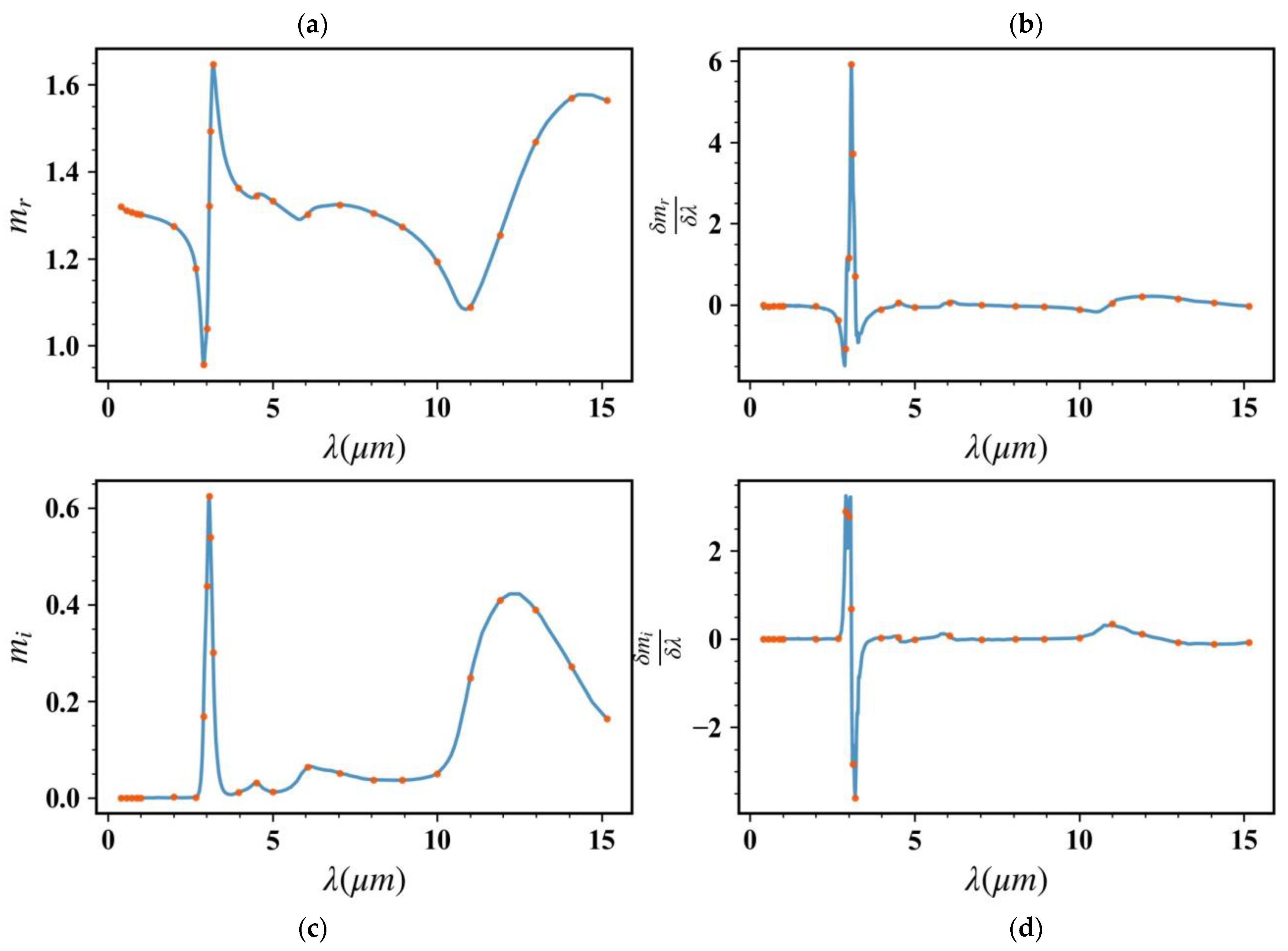
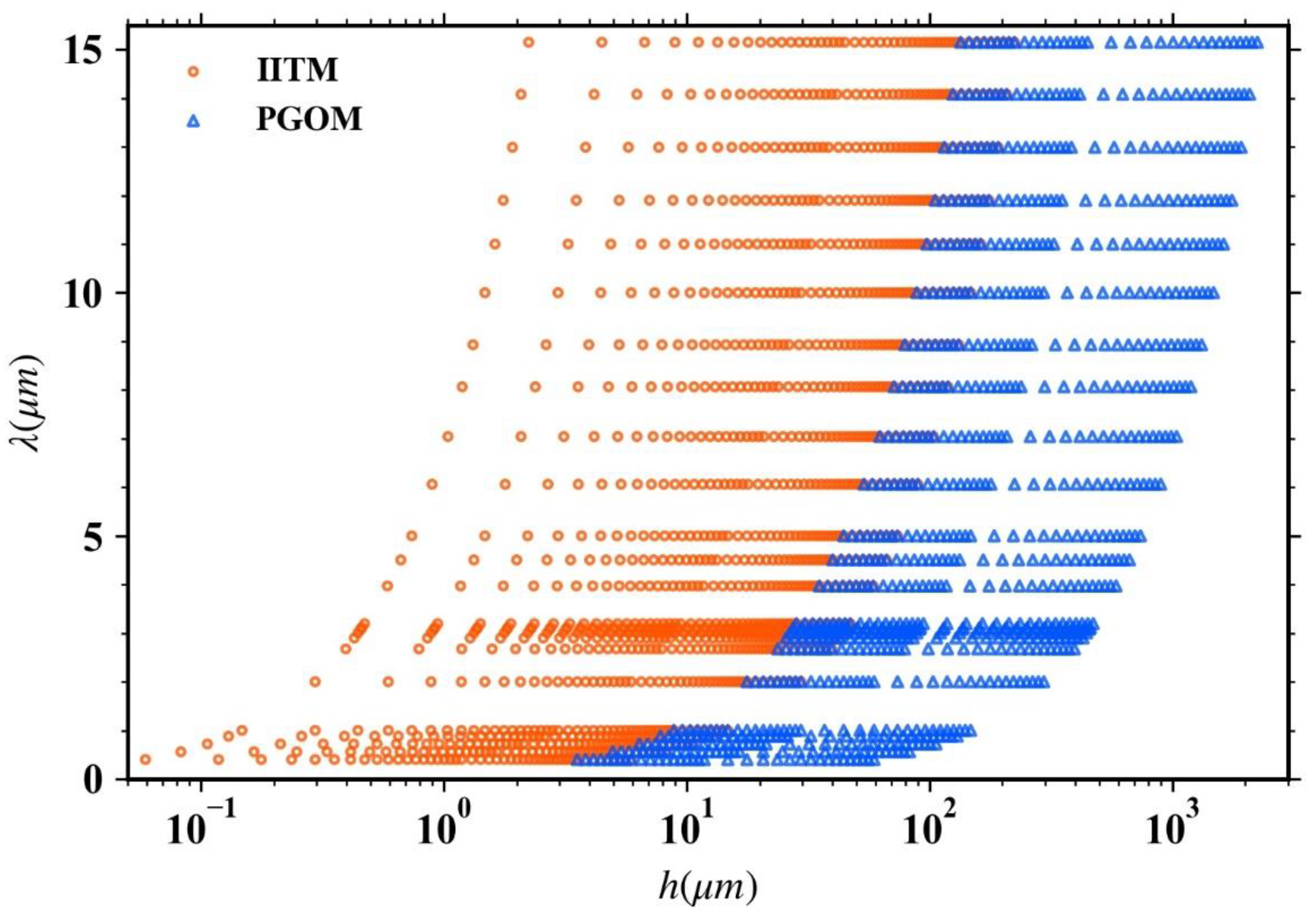
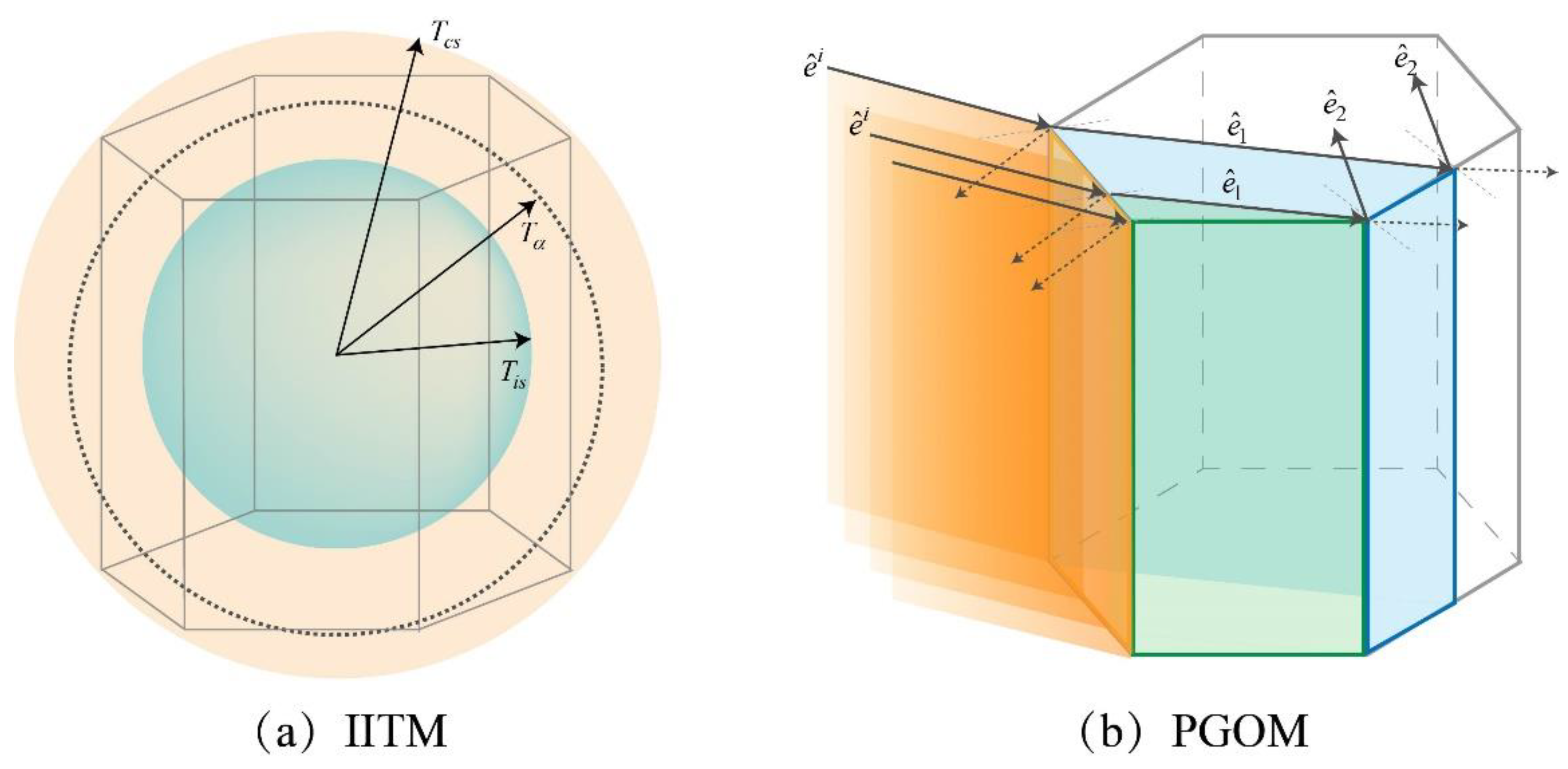
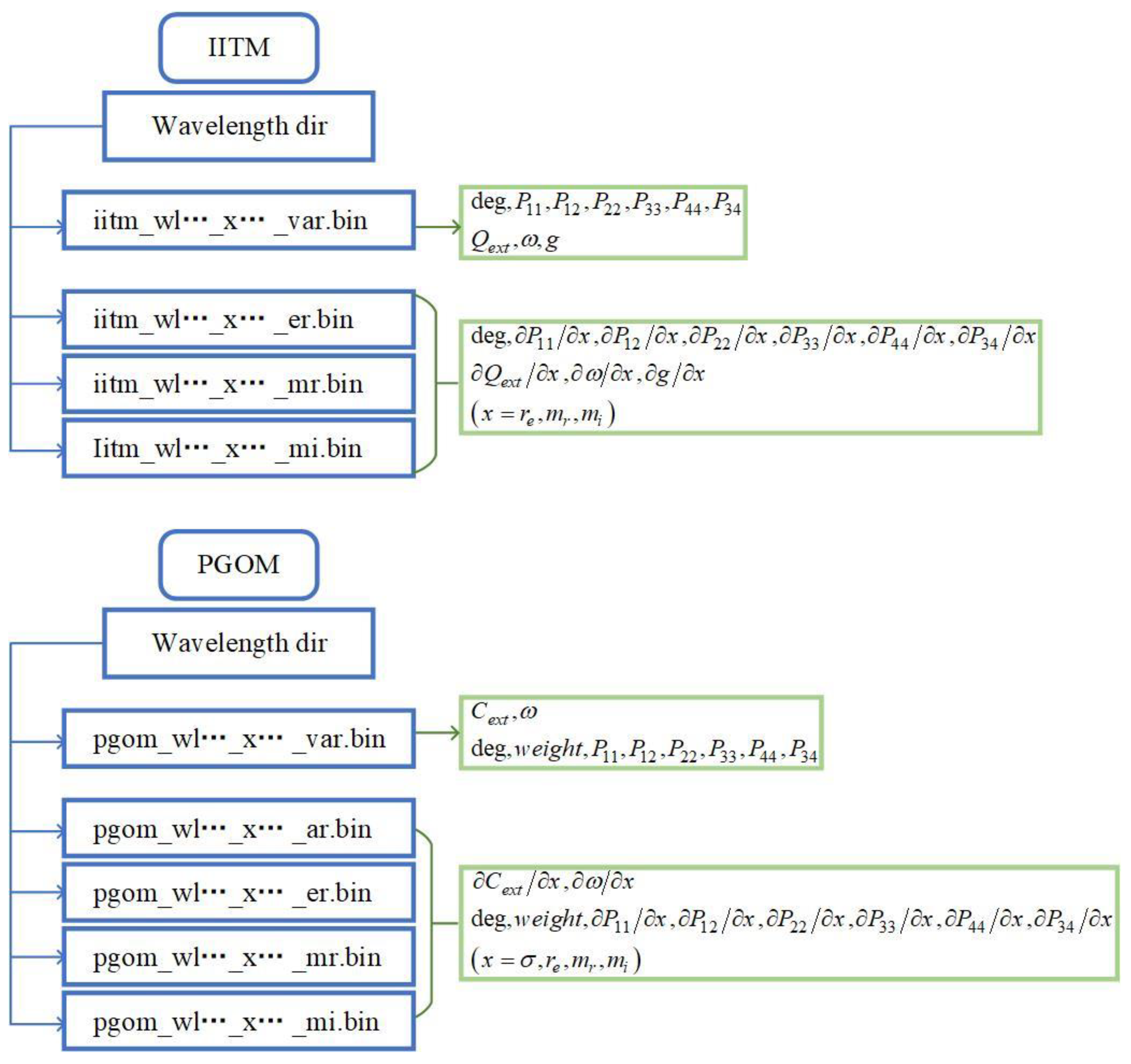
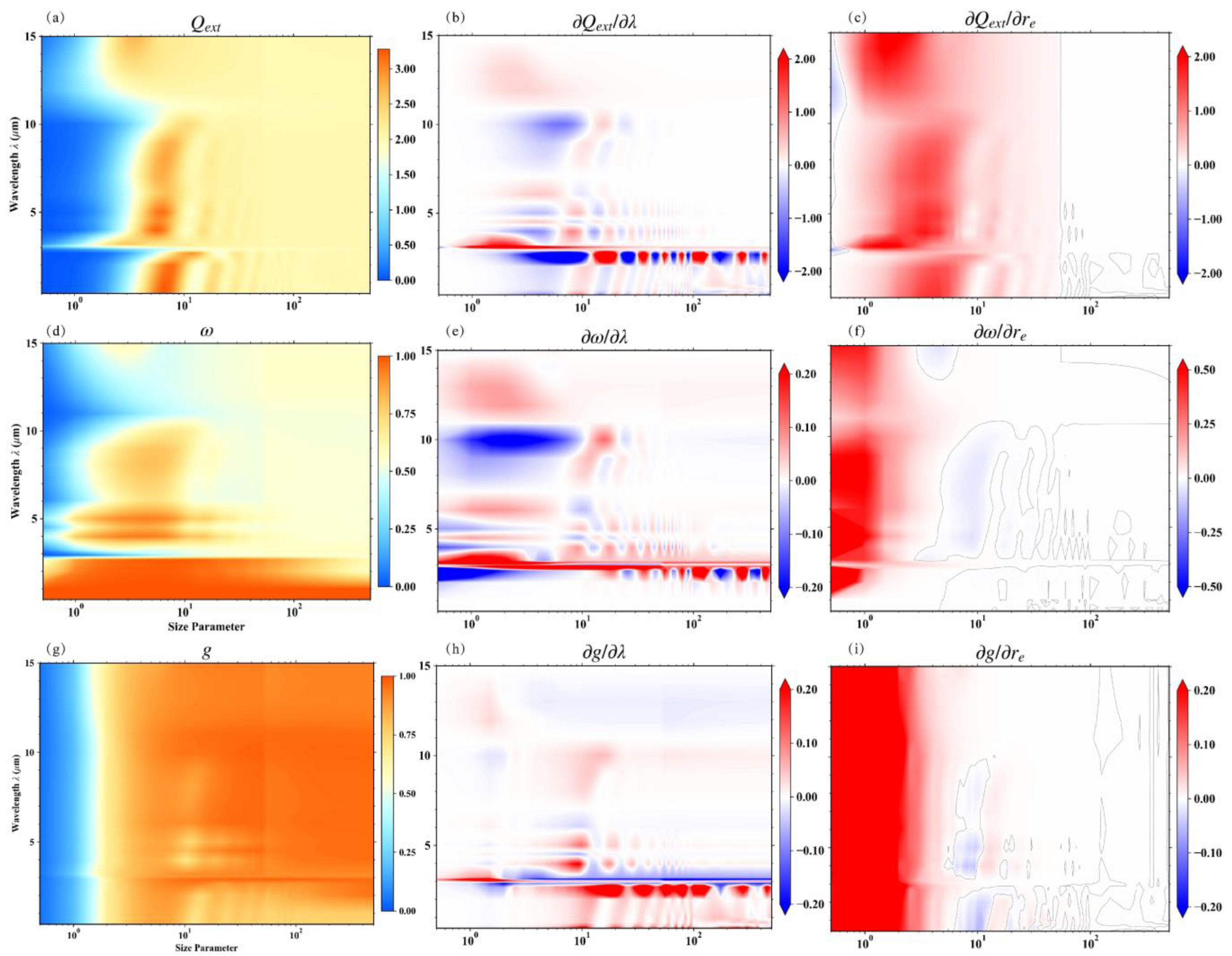

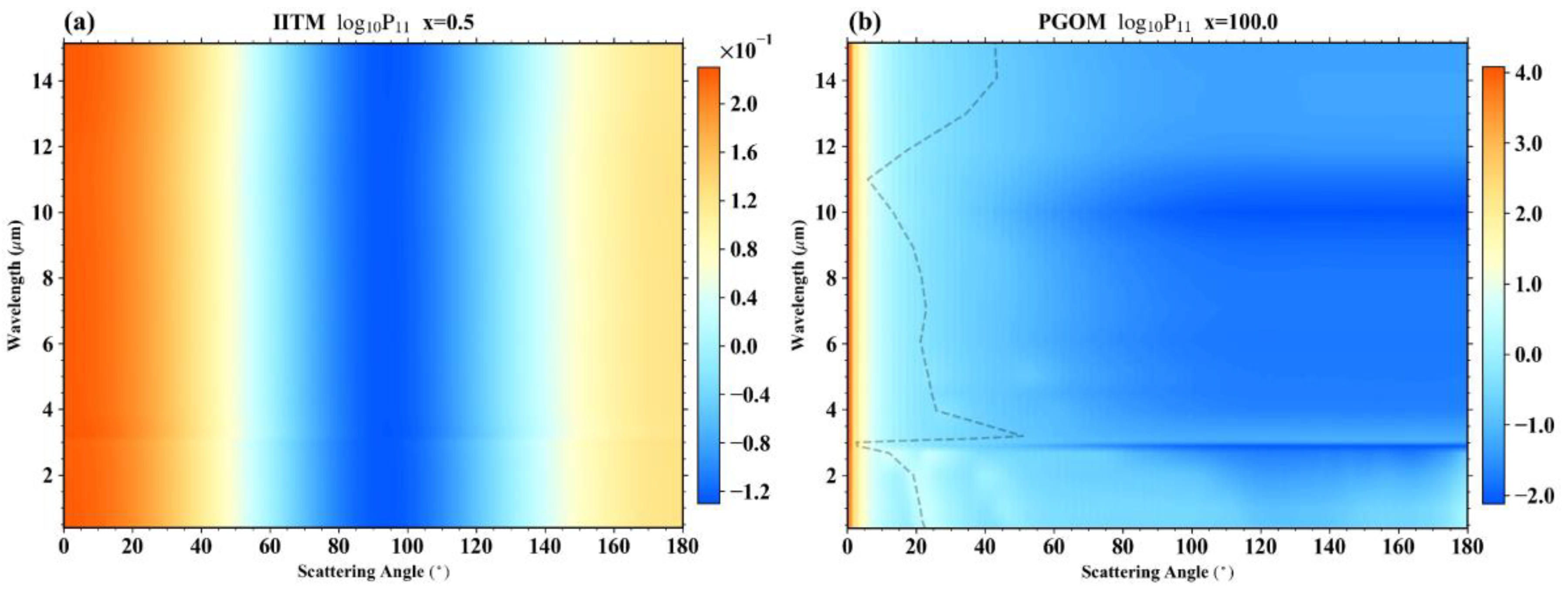
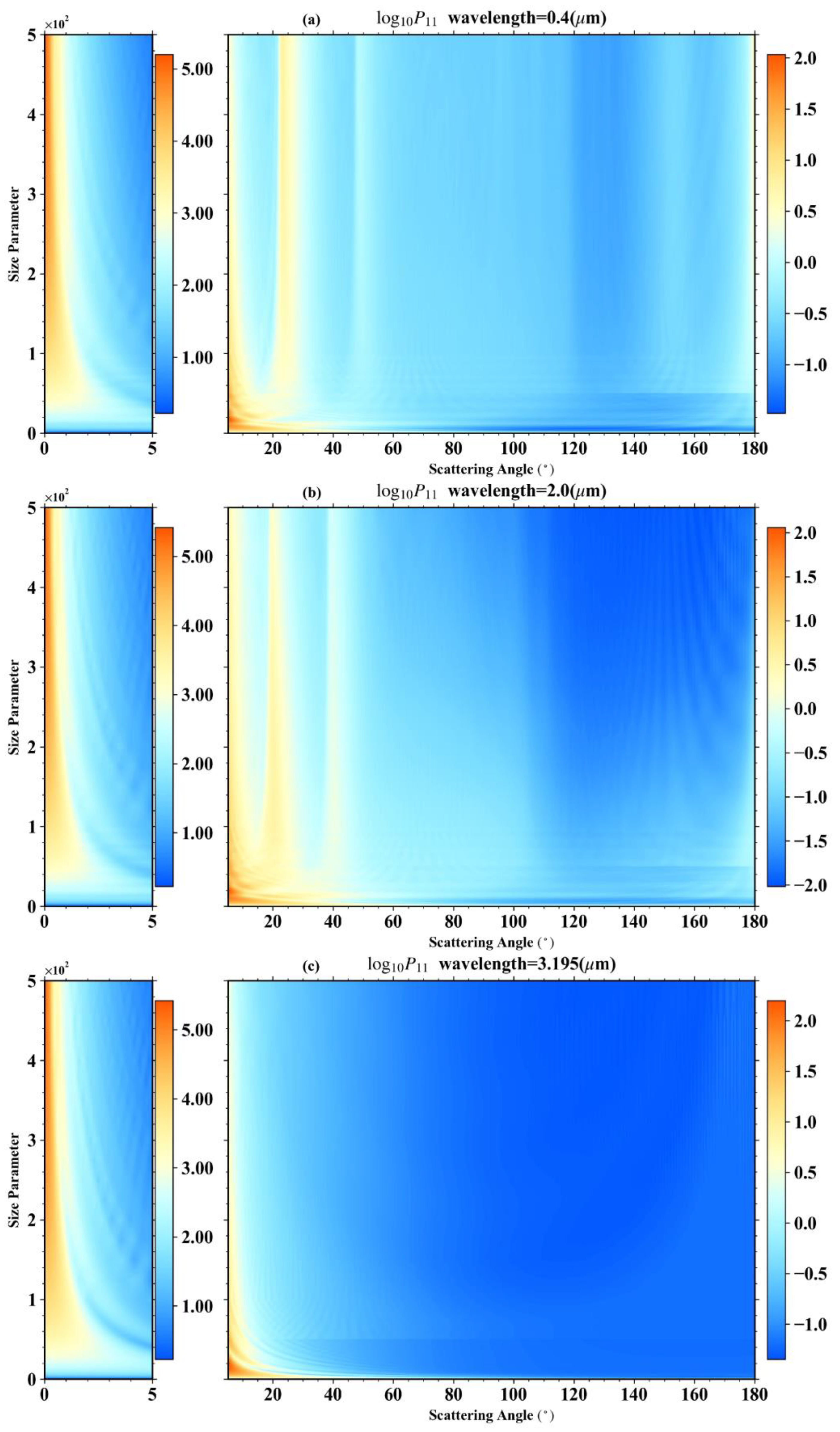
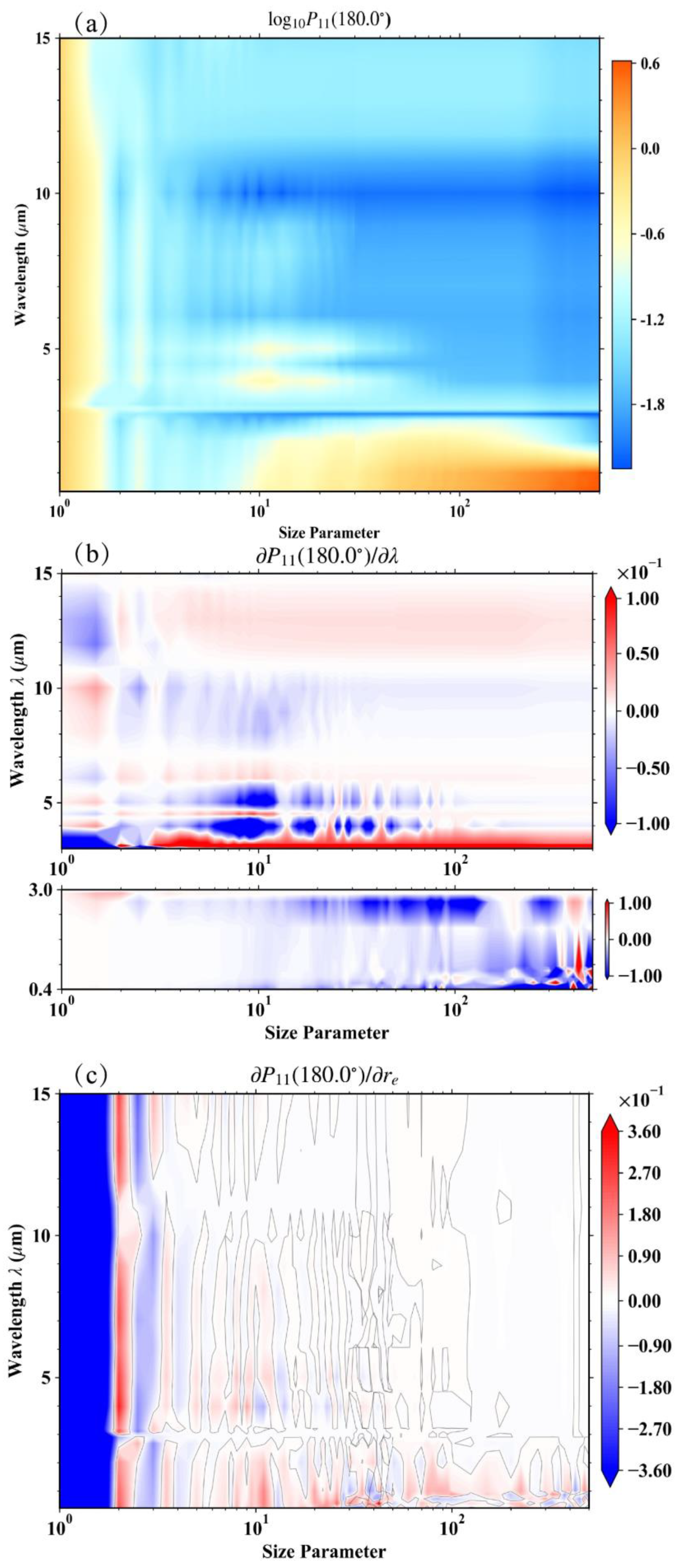
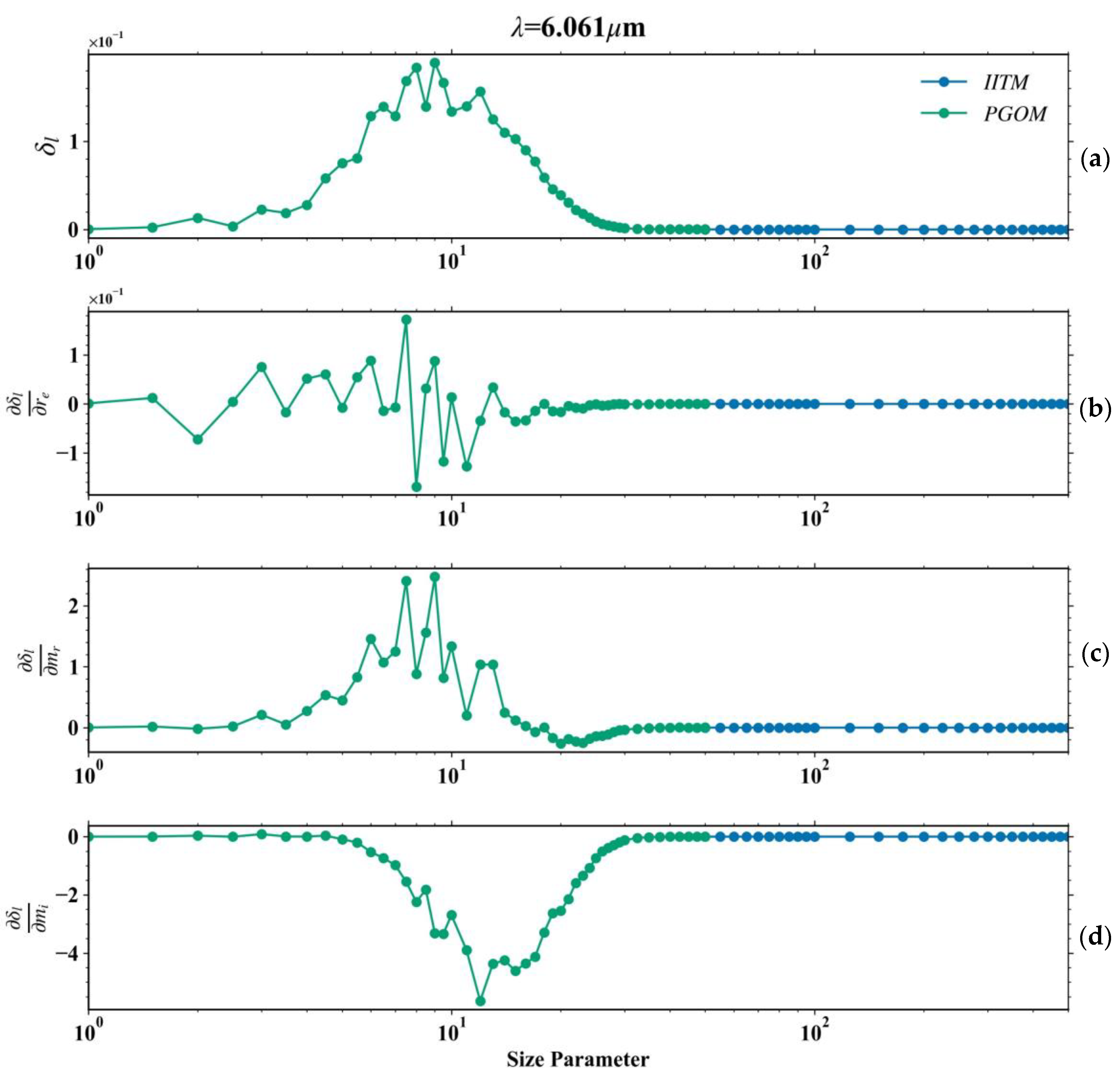
| Parameters | Grid Points |
|---|---|
| x (IITM) | 0.5, 1.0, 1.5, 2.0, 2.5, 3.0, 3.5, 4.0, 4.5, 5.0, 5.5, 6.0, 6.5, 7.0, 7.5, 8.0, 8.5, 9.0, 9.5, 10.0, 11.0, 12.0, 13.0, 14.0, 15.0, 16.0, 17.0, 18.0, 19.0, 20.0, 21.0, 22.0, 23.0, 24.0, 25.0, 26.0, 27.0, 28.0, 29.0, 30.0, 32.5, 35.0, 37.5, 40.0, 42.5, 45.0, 47.5, 50.0 |
| x (PGOM) | 30.0, 32.5, 35.0, 37.5, 40.0, 42.5, 45.0, 47.5, 50.0, 55.0, 60.0, 65.0, 70.0, 75.0, 80.0, 85.0, 90.0, 95.0, 100.0, 125.0, 150.0, 175.0, 200.0, 225.0, 250.0, 275.0, 300.0, 325.0, 350.0, 375.0, 400.0, 425.0, 450.0, 475.0, 500.0 |
| λ | 0.400, 0.560, 0.720, 0.880, 1.000, 2.000, 2.675, 2.899, 3.003, 3.077, 3.115, 3.195, 3.9690, 4.505, 5.000, 6.061, 7.042, 8.065, 8.929, 10.000, 11.000, 11.900, 12.990, 14.080, 15.150 |
Publisher’s Note: MDPI stays neutral with regard to jurisdictional claims in published maps and institutional affiliations. |
© 2022 by the authors. Licensee MDPI, Basel, Switzerland. This article is an open access article distributed under the terms and conditions of the Creative Commons Attribution (CC BY) license (https://creativecommons.org/licenses/by/4.0/).
Share and Cite
Gao, C.; Liang, D.; Sun, B.; Liu, J.; Liu, Z. Linearized Single-Scattering Property Database for Hexagonal Prism Ice Particles. Remote Sens. 2022, 14, 6138. https://doi.org/10.3390/rs14236138
Gao C, Liang D, Sun B, Liu J, Liu Z. Linearized Single-Scattering Property Database for Hexagonal Prism Ice Particles. Remote Sensing. 2022; 14(23):6138. https://doi.org/10.3390/rs14236138
Chicago/Turabian StyleGao, Chenxu, Dongbin Liang, Bingqiang Sun, Jian Liu, and Zhaoyuan Liu. 2022. "Linearized Single-Scattering Property Database for Hexagonal Prism Ice Particles" Remote Sensing 14, no. 23: 6138. https://doi.org/10.3390/rs14236138
APA StyleGao, C., Liang, D., Sun, B., Liu, J., & Liu, Z. (2022). Linearized Single-Scattering Property Database for Hexagonal Prism Ice Particles. Remote Sensing, 14(23), 6138. https://doi.org/10.3390/rs14236138







